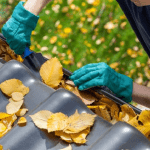Moisture and water in the basement primarily comes from two kinds of sources. The first source is indoor humidity which will condense and form droplets of water, and the second reason is water vapor or water itself which comes from outside. Melting snow, rainwater and groundwater can saturate soil around the foundations of your house, thus allowing water to come in. water can even leak through cracks, penetrate porous masonry and concrete walls in its vapor form. To understand which problem it is, use aluminum foil to tape to the basement wall and look at it a few days afterwards. If there is moisture on the outer surface, then there is quite high humidity indoors, and moisture behind foil means that it is leaking through the walls. Now that we have figured out which of the two it is, let’s look at how to tackle this problem.
- No Excess Humidity: while doing basement waterproofing there should not be any humid air around. You should seal the dryer vents with tape to cut off the excess air that enters. Just taping will not do, it tends to fall off easily, instead, also add a vent fan to the basement bathroom and use it during showers. Also keep basement windows closed when there’s humid weather. Even better is a dehumidifier.
- Insulation of Pipes: if there is condensation coming from cold pipes, they add to the basement water issues. All cold water pipes need to be covered with foam pipe insulation in order to halt condensation. This is an essential step in basement waterproofing. You will find that foam insulation is quite cheap and easily cut by scissors.
- Wall insulation: the exterior walls must be insulated to prevent any condensation. In colder climates, if you insulate your basement walls, it saves energy and reduces electricity costs. The only problem you might face is the occasional mold.
- Water Separate from Foundation: if you find your basement leaking after a spell of heavy rain or snow, you should ensure that the water is diverted away from the basement. It is quite common for soil along the house to settle down over time and create a moat which will collect the runoff and direct it down the walls of the foundation and inside the basement. This problem can be solved by erecting a six feet wide slope which will drop about 4 inches away from the foundation. Cover the soil that is sloping with a 6 mm poly. Then you need to cover the poly with gravel and grass as well as a layer of soil so that the water does not soak in near the foundation.
- Adding gutters and extending downspouts: consider adding gutters if your basement starts to leak after a spell of rain. Whether it is an old or a new gutter, the downspouts should have four to six feet of horizontal extensions to remove the water from your house.
- Plugging holes and cracks: if you use hydraulic cement to seal the basement holes, it works best because it sets even underwater, and it expands as it sets. This gets rid of any small channels as well, just follow the packaging instructions and you should be able to do it, it’s quite easy.
- Waterproofing walls: remove loose material with the help of a wire brush, clean off any efflorescence with masonry cleaner. You should follow the instructions carefully, especially the section on safety precautions.
Water in the basement is a common problem, and it is a good DIY on a lazy summer afternoon. Just be diligent and pay attention to the work you are doing, and basement waterproofing should not be much of a headache.







